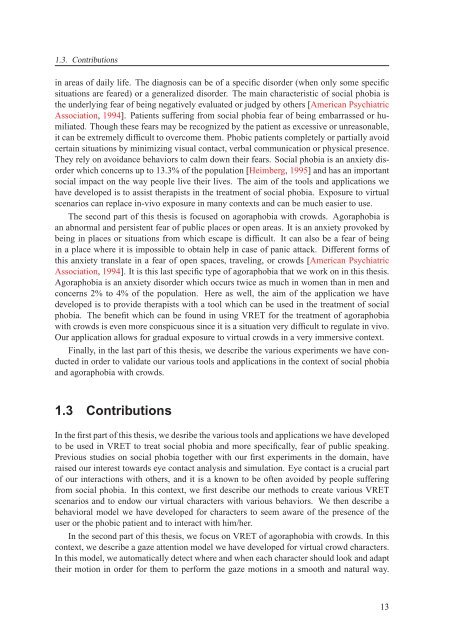Texte intégral / Full text (pdf, 20 MiB) - Infoscience - EPFL
Texte intégral / Full text (pdf, 20 MiB) - Infoscience - EPFL
Texte intégral / Full text (pdf, 20 MiB) - Infoscience - EPFL
You also want an ePaper? Increase the reach of your titles
YUMPU automatically turns print PDFs into web optimized ePapers that Google loves.
1.3. Contributions<br />
in areas of daily life. The diagnosis can be of a specific disorder (when only some specific<br />
situations are feared) or a generalized disorder. The main characteristic of social phobia is<br />
the underlying fear of being negatively evaluated or judged by others [American Psychiatric<br />
Association, 1994]. Patients suffering from social phobia fear of being embarrassed or humiliated.<br />
Though these fears may be recognized by the patient as excessive or unreasonable,<br />
it can be extremely difficult to overcome them. Phobic patients completely or partially avoid<br />
certain situations by minimizing visual contact, verbal communication or physical presence.<br />
They rely on avoidance behaviors to calm down their fears. Social phobia is an anxiety disorder<br />
which concerns up to 13.3% of the population [Heimberg, 1995] and has an important<br />
social impact on the way people live their lives. The aim of the tools and applications we<br />
have developed is to assist therapists in the treatment of social phobia. Exposure to virtual<br />
scenarios can replace in-vivo exposure in many con<strong>text</strong>s and can be much easier to use.<br />
The second part of this thesis is focused on agoraphobia with crowds. Agoraphobia is<br />
an abnormal and persistent fear of public places or open areas. It is an anxiety provoked by<br />
being in places or situations from which escape is difficult. It can also be a fear of being<br />
in a place where it is impossible to obtain help in case of panic attack. Different forms of<br />
this anxiety translate in a fear of open spaces, traveling, or crowds [American Psychiatric<br />
Association, 1994]. It is this last specific type of agoraphobia that we work on in this thesis.<br />
Agoraphobia is an anxiety disorder which occurs twice as much in women than in men and<br />
concerns 2% to 4% of the population. Here as well, the aim of the application we have<br />
developed is to provide therapists with a tool which can be used in the treatment of social<br />
phobia. The benefit which can be found in using VRET for the treatment of agoraphobia<br />
with crowds is even more conspicuous since it is a situation very difficult to regulate in vivo.<br />
Our application allows for gradual exposure to virtual crowds in a very immersive con<strong>text</strong>.<br />
Finally, in the last part of this thesis, we describe the various experiments we have conducted<br />
in order to validate our various tools and applications in the con<strong>text</strong> of social phobia<br />
and agoraphobia with crowds.<br />
1.3 Contributions<br />
In the first part of this thesis, we desribe the various tools and applications we have developed<br />
to be used in VRET to treat social phobia and more specifically, fear of public speaking.<br />
Previous studies on social phobia together with our first experiments in the domain, have<br />
raised our interest towards eye contact analysis and simulation. Eye contact is a crucial part<br />
of our interactions with others, and it is a known to be often avoided by people suffering<br />
from social phobia. In this con<strong>text</strong>, we first describe our methods to create various VRET<br />
scenarios and to endow our virtual characters with various behaviors. We then describe a<br />
behavioral model we have developed for characters to seem aware of the presence of the<br />
user or the phobic patient and to interact with him/her.<br />
In the second part of this thesis, we focus on VRET of agoraphobia with crowds. In this<br />
con<strong>text</strong>, we describe a gaze attention model we have developed for virtual crowd characters.<br />
In this model, we automatically detect where and when each character should look and adapt<br />
their motion in order for them to perform the gaze motions in a smooth and natural way.<br />
13

















